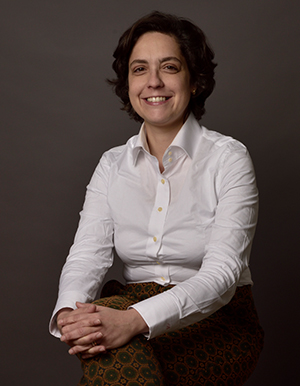Rita Ventura Lab

 |
Bioorganic Chemistry is the interface of organic chemistry and biology. Our research uses the principles and techniques of organic chemistry in attempting to solve problems of relevance to biology. We can design synthetic derivatives of natural products, that improve on nature. |
|
Rita Ventura Phone (+351) 214469775/78 |
|
 |
Research Interests
Our group is interested in the stereoselective synthesis of new biologically active compounds in order to enhance or modulate their properties and to contribute to the understanding of their biological roles and for the discovery of new drug targets. This knowledge is important for the design and synthesis of new molecules that can interfere with the molecular mechanisms responsible for pathogenic behaviours, with potential innovative therapeutic applications.
The main interests of the Bioorganic Chemistry Group are the design and synthesis of new organocatalysts from readily available chiral starting materials for enantioselective reactions, for example reactions that require photochemical activation. We are pursueing the synthesis and optimisation of new AI-2 prodrugs, namely AI-2 linked to glycosides that will ensure the specific delivery of AI-2 to the gut and avoid degradation by oral administration. Our expertise in the chemistry of AI-2, a very unstable molecule, is being used to synthesise new AI-2 derived probes for biological studies.
Our group has a long experience in carbohydrate synthesis, including the development of high stereoselective glycosylation reactions to be applied to the synthesis of di- and higher saccharides. We are also using biocatalysis to overcome the regio- and stereoselective challenges in the synthesis of complex carbohydrate molecules.
Ongoing projects are: the synthesis of sugar derived new molecular probes designed to inhibit galactosyltransferases specific of Trypanosoma brucei and other pathogenic microorganisms, to discover new drug targets and develop new drug candidates; the synthesis of new inhibitors of enzymes involved in the assembly of the unique lipid-rich cell wall of Mycobacteria, including Mycobacteria tuberculosis.
The synthesis of fluorescence labelled molecules used in biological studies, such as antibiotics, is another ongoing project.
The synthesis of new analogues of (poly)phenol metabolites, with potential applications in neuredegenerative and cardiovascular diseases.
Another aim is to design and develop efficient asymmetric synthesis of oleocanthal, oleacein and corresponding metabolites found in virgin olive oil (VOO) and biological fluids after VOO consumption. The new syntheses will provide (-)-oleocanthal and (-)-oleacein with high chemical and optical purity and in sufficient amounts to be used as standards and further biological tests. Our concern is also to develop more atom economic syntheses for a greener and more affordable approach.
NOTE: AI-2 and related compounds are available for sale.
Group Members
- Peter Kis – ERA-Postdoctoral Researcher
- Márcia Rénio - PhD Researcher
- Beatriz Martins - PhD student (co-supervisor Rosário Bronze, FFUL, iBET)
- Cristiano Conceição – PhD student (co-supervisor Margarida Archer, ITQB NOVA)
- Miguel Rodrigues - PhD student (co-supervisor Karina Xavier, IGC)
- Miguel Mira - PhD student (co-supervisors Soraia Santos and Vânia Batalha, BIAL)
- Inês Paiva - PhD student (co-supervisor Cláudia Santos, NMS)
- Inês Afonso – BI Researcher
- Márcia Saraiva – BI Researcher
- Bárbara Rebelo - PhD student (Supervisor Rita Abranches, ITQB NOVA)
- Diana Silva - PhD student (Supervisor Ulrich Grädler, Merck, co-supervisor Tiago Bandeiras, iBET)
Selected Publications
-
Miranda, V.; Torcato, I. M.; Xavier, K. B.; Ventura, M. R. “Synthesis of D-desthiobiotin-AI-2 as a novel chemical probe for autoinducer- 2 quorum sensing receptors.” Bioorganic Chemistry 2019, 92, 1032002. https://doi.org/10.1016/j.bioorg.2019.103200.
-
Rénio, M.; Murtinho, D.; Ventura, M. R. “New bifunctional 1,3-diamine organocatalysts derived from (+)-camphoric acid for asymmetric Michael addition of 1,3-dicarbonyl compounds to nitroolefins” Chirality 2022, DOI: 10.1002/chir.23424.
-
Rebelo, B. A.; Santos, R. B.; Ascenso, O. S.; Nogueira, A. C.; Lousa, D.; Abranches, R.; Ventura, M. R. “Synthesis and biological effects of small molecule enhancers for improved recombinant protein production in plant cell cultures.” Bioorganic Chemistry 2020, 94, 103452. https://doi.org/10.1016/j.bioorg.2019.103452.
-
Taborda, A.; Frazão, F.; Rodrigues, M. V.; Fernández-Luengo, X.; Sancho, F.; Lucas, M. F.; Frazão, C.; Ventura, M. R.; Masgrau, L.; Borges, P. T.; Martins, L. O. “Mechanistic Insights into Glycoside 3-Oxidases Involved in C-Glycoside Metabolism in Soil Microorganisms” Nat Commun 2023, 14, 7289. https://doi.org/10.1038/s41467-023-42000-3.
Laboratory's Website
For further information please visit the laboratory's website.
Química Bioorgânica (PT)
A Química Bioorgânica é a interface entre a química orgânica e a biologia. A nossa investigação usa os princípios e técnicas de química orgânica para tentar resolver problemas relevantes na área da biologia. Podemos também desenvolver derivados sintéticos com propriedades melhores que as correspondentes moléculas naturais, contribuindo para melhorar e perceber a natureza.
O nosso grupo está interessado na síntese de moléculas pequenas que podem atuar como catalisadores – organocatalisadores – e que podem ser usados na construção de moléculas orgânicas enantiopuras, sendo uma alternativa aos catalisadores contendo metais e enzimas.
Outra área de investigação no nosso grupo é a química de carbohidratos. Um dos alvos é a síntese de moléculas que sejam substratos específicos de enzimas envolvidas na síntese de oligossacáridos importantes para a construção da parede celular das microbactérias, incluindo a Mycobacteria tuberculosis. Essas enzimas são potenciais alvos terapêuticos, e a síntese de análogos que as inibam especificamente é outro interesse do grupo. A síntese de novas moléculas desenhadas para inibir galactosiltransferases específicas do Trypanosoma brucei está a ser desenvolvida, para descobrir novos alvos terapêuticos e novos potenciais fármacos.
Em colaboração com o grupo de Sinalização Bacteriana, desenvolvemos uma síntese eficiente da 4,5-dihidroxi-2,3-pentanodiona (DPD), precursor do AI-2, um autoindutor de “deteção de quorum” que regula a comunicação inter-espécies entre bactérias, processo responsável por comportamentos bacterianos tais como a formação de biofilmes, virulência e produção de antibióticos. Novos análogos desta molécula estão a ser desenvolvidos, para atuarem com pró-fármacos, e como novas sondas para melhor estudar os processos onde o AI-2 está envolvido.







